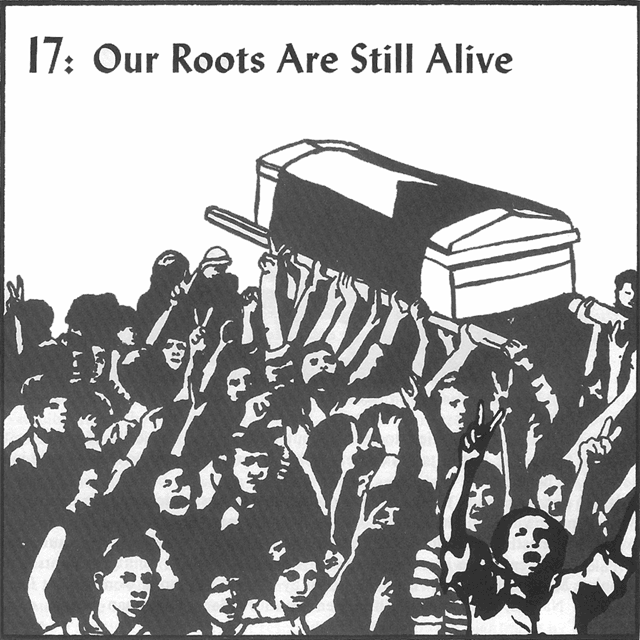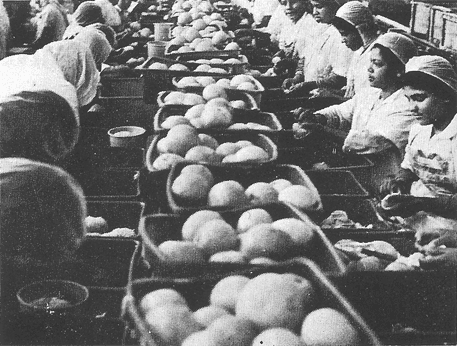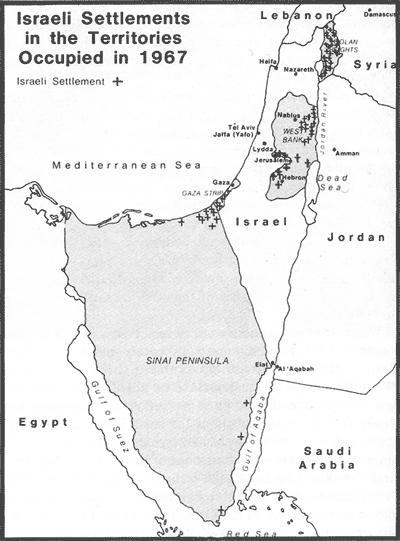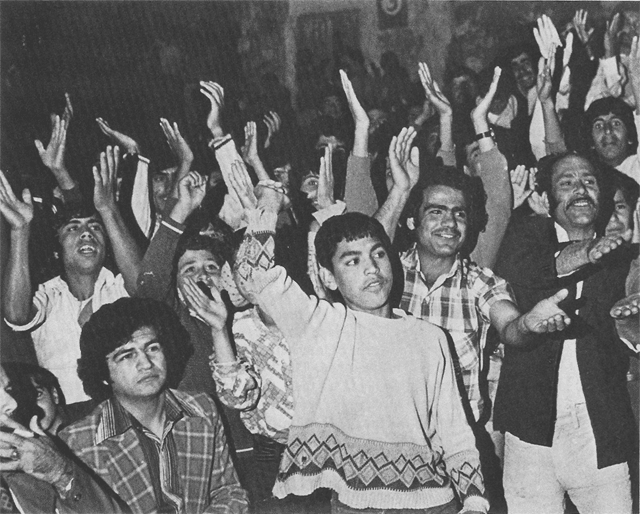Our Roots Are Still Alive - Chapter 17
Previous: Chapter 16
Table of Contents
Next: Chapter 18
New Jersey Solidarity-Activists for the Liberation of Palestine Main Site

- This village belongs to Palestine, not to Israel!
- Chant of Palestinian demonstrators
Israeli authorities hoped that the West Bank demonstrations during Arafat's visit to the United Nations were isolated events. West Bank Palestinians shattered those hopes throughout 1975. Despite harsh Israeli bans on any kind of demonstration, people took to the streets to protest attacks on Palestinians in Lebanon and to march against the Sinai Accords. In small groups and in large rallies, they showed their support for the PLO before being quickly dispersed by Israeli troops. At night they put up posters and painted pro-PLO slogans on the walls. What Israeli leaders had feared for years was beginning to happen: the Palestine National Front was providing an organized link between Palestinians in exile and Palestinians under occupation.
The Israelis used all the devices of military occupation to stop the Front's activities. They conducted random searches of homes and arrested large numbers of West Bankers on suspicion of being Front members. Harsh questioning gave way to torture as the occupiers tried to learn about and destroy the cells of the Front. Suspects faced long prison terms and expulsion from the territories if they were just accused of hostile acts.1

Palestinian women pack Gaza oranges in crates marked 'Product of Israel'.
It did not take much to prompt the occupation troops to action. One day in the West Bank town of Bireh, Israeli soldiers stormed into the city hall. They tore an exhibit of Palestinian folklore off the wall and buried it in a cellar. Any resurgence of Palestinian culture was considered threatening to Israel's ability to control its colonies. Moshe Dayan, on reading a poem by Fadwa Toquan, a woman poet from occupied Nablus, exclaimed, "This poem is more dangerous than twenty commandos!"
The Palestine National Front encouraged a wide range of cultural resistance. The poems of Toquan, who was a descendant of the famous poet of the 1936 Rebellion, appeared in the pages of Falastin, the underground newspaper of the Front. A nod to an Arab newsboy in Jerusalem got the buyer a copy of this paper stuffed between the pages of an Arabic daily. The Front's theatre groups hastily set up makeshift stages and performed in small villages in the West Bank. On weekend nights in Jerusalem, teenagers gathered for the usual parties, but they sang new songs about the liberation of Palestine. The Israeli repression could not stop all these visible acts of resistance.
Squeezing Blood from a Stone
Israel's economic policies in the occupied territories were generating resistance much faster than Israel's police or military could possibly discover and destroy it. Israel had been extracting wealth from the territories since the first days of occupation. The West Bank and Gaza were already second only to the United States as a market for Israeli goods. Many people in the occupied territories were unemployed or served as cheap labor for Israeli industries. Palestinians got only one-half the wages paid to a Jewish worker and none of the unemployment insurance, health insurance or sick leave that Jewish workers received. By not paying these benefits to Palestinian workers, Israel's industries saved an estimated $260 million between 1968 and 1974.2
The jobs that were open to the Palestinians were among the hardest and dirtiest - jobs that many Israelis did not want. Thus, the half of all Palestinian wage-earners in the territories who traveled every day by bus to Israel worked as cooks, factory workers, dishwashers, laborers, construction workers or agricultural workers on the kibbutzim. At the end of the day they returned by bus to the West Bank or Gaza, forbidden by law to remain overnight in Israel.
Palestinians who had received a university education or were professionals or highly skilled found no place to use their training in the territories or inside Israel. The Israelis encouraged such people to emigrate. An average of forty thousand Palestinians left the West Bank and Gaza each year, some as a result of expulsion, others to look for work elsewhere. Many found jobs as engineers and technicians in the oil-producing countries of the Arabian Gulf. From there they sent money back to their families.
Whether breadwinners went to Israel each day or to another country to earn their wages, by 1973 their incomes could barely match the growing needs of their families. Despite this, the Israeli government tried to squeeze even more from the Palestinians to help Israel survive its post-October War financial crisis. Israel levied new taxes on the already hard-pressed Arab businesses, and increased old taxes at a steady rate. It ended subsidies for basic foods, and raised the price of other Israeli goods. But such moves were like trying to get blood out of a stone. Rising prices put more and more essential items out of the reach of Palestinians, especially those with large families. Lagging Israeli industries began to lay off Palestinian workers. With their husbands laid off, some Palestinian women managed to find even lower-paying jobs in new factories in the Gaza Strip. There they packaged oranges grown by Gaza farmers into cartons marked "Products of Israel."
The Palestine National Front responded to this growing nightmare by calling for an immediate end to the Israeli occupation. Front organizers explained that there could be no stopping the constant economic, military and cultural attacks until the Palestinians had their independence. Neither Israel nor Hussein could solve the Palestinians' problems.
Palestinians answered the Front's call with a series of strikes and demonstrations demanding independence. In November of 1975 demonstrators in the West Bank cities of Hebron, Halhoul and Jerusalem marked the anniversary of the PLO appearance at the United Nations by piling rocks in the road to keep out Israeli patrols. Carrying Palestinian flags and chanting slogans calling for independence and denouncing the Israeli occupation and King Hussein, demonstrators blocked the road to the al-Amari refugee camp in the West Bank. Throughout the West Bank Palestinian flags flew from the top of mosques or hung from windows. Although Israeli troops patrolled Nablus and Ramallah all night, each morning soldiers found new slogans painted on the walls. One slogan appeared again and again: "Long Live the PLO!"

That same month the PLO took the case of the Palestinians to the United Nations once again. The General Assembly passed three resolutions, including one which insisted that the "inalienable right of the Palestinian people to self-determination" be the basis for any future negotiations on the Middle East. Western media barely mentioned this resolution as they mounted a savage attack on the resolution which rightfully called Zionism a form of racism. Israel responded to these UN resolutions by bombing Palestinian refugee camps in southern Lebanon, killing ninety-two people. The U.S. government stood almost alone in defense of Israel in the United Nations. It cast a lone veto in the Security Council against a resolution affirming the national rights of the Palestinians on January 26, 1976.
No to the Occupation!
As news of the U.S. veto came over West Bank radios, students from three Nablus high schools charged out of their classrooms, chanting slogans in support of the PLO and against the United States. Joined by workers who had received leaflets predicting the veto on their way to work, the demonstrators converged in the casbah, the ancient center of Nablus - largest town in the West Bank. Running through the maze of alleyways, they kept Israeli soldiers at bay. Ramallah, Jerusalem and Bireh followed the lead of Nablus. This wave of demonstrations lasted for three months and shattered all Israeli illusions that the West Bank would not fight occupation.
Major targets of the demonstrations were the new Zionist settlements in the West Bank. Since the beginning of the occupation, the Israeli government had been illegally building new Jewish settlements in the territories. An Israeli official told Terrence Smith in a May 1976 New York Times interview:
- Look at the chain of settlements on a map and you will see what we intend to be the future borders of Israel.
Palestinians knew that these settlements threatened the future independence of the West Bank.
On March 7 Palestinian students in a Nablus schoolyard held a peaceful demonstration against the nearby settlement of Kadum. Israeli soldiers burst into the courtyard, pursued students into classrooms and beat them brutally. The people of Nablus went out on strike and the entire municipal council resigned. Surrounding villages joined the fighting.
When the demonstrations did not cease, Israeli troops began to shoot to kill. The first casualty was an eleven-year-old boy, Ali Husain al Sana, killed in a suburb of Jerusalem. At his funeral crowds followed his coffin carrying olive branches and flowers. Over and over again the crowd chanted "Abu Ammar," the code name of PLO leader Yasser Arafat. Palestinians in Jerusalem observed a general strike. Israeli tanks moved in to surround the city, but they could not enter the Old City. A leader of the Palestine National Front explained why:
- These demonstrations reached their peak with the massive resistance in Jerusalem with students and people throwing stones and firebombs and fire torches at the Israeli soldiers. The Old City was totally controlled by the Palestinian patriots and no Israeli soldiers were able to enter it. When they tried to enter the women and children would throw flower pots and hot water and hot oil on them in the narrow streets.3
In the spring of 1976 a new Palestinian force joined the fight against Israel. For the first time since the creation of the Jewish state, the Palestinian population of the Galilee - the Palestinians who live inside Israel and are Israeli citizens - responded to their oppression in the same way as Palestinians in the territories, with prolonged strikes and demonstrations.
Trouble had been brewing in the Galilee for some time. Seventy percent of all Palestinians in Israel lived there. David Ben-Gurion once said, "Whoever tours the Galilee gets the feeling that it is not part of Israel."4 In the eyes of Israeli leaders, it had too many Arabs and not enough Jews. According to a publication of the Ministry of Agriculture:
- It is necessary to change the existing situation regarding the demographic ratio between the Jewish population and the non-Jewish, by means of implementing a long-term development program.5
A "development program" meant more land confiscation. The state set out to "Judaize" the area by building new Jewish settlements, like the industrial town of upper Nazareth, on Arab land. Israel's planners assumed that years of repression and the cooperation of local Arab leaders loyal to Israel would prevent any protest by Israel's Arabs. They were wrong. In December of 1975 the people of Nazareth, the largest town in the Galilee, elected Tawfiq Zayyad as their mayor. Zayyad, a member of Rakah, the Israeli Communist Party, ran on a program calling for an end to discrimination against Palestinians and an end to land confiscation.
Israeli government officials went all out to stop his election. They offered the people of Nazareth the return of some land if Zayyad was not elected. They made veiled threats against his life. Moshe Barain, the Minister of the Interior, said, "the people of Nazareth must not imagine that the state of Israel would allow the town administration to fall into the hands of an admitted agent of Arafat."6 But for most people both the threats and the promises had a hollow ring.
Nazareth had no industries, no public library, no social services. A majority of its inhabitants, like those of the occupied territories, left their town every day to work in menial jobs in Israeli industry. From their windows many could see land they once farmed. Now as "non-Jews" they could not live on, rent, or even be employed on land that had belonged to their families for generations. They were ready to resist. A poem written by Zayyad several years before, called "We Shall Remain," expressed the new spirit of resistance among Palestinians living inside Israel:
- It is a thousand times easier
For you
To pass an elephant through the needle's eye
To catch fried fish in the milky way
To plow the sea
To teach the alligator speech
A thousand times easier
Than smothering with your oppression
The spark of an idea.
Here we shall remain
A wall on your chests.
We wash dishes in the hotel
And serve drinks to the masters.
We mop the floors in the dark kitchens
To extract a piece of bread
From your blue teeth
For the little ones.
Here we shall remain
A wall on your chests
We starve,
Go naked,
Sing songs
And fill the streets
With demonstrations
And the jails with pride.
 Palestinians in the Galilee applaud a speech by Tawfiq Zayyad
Palestinians in the Galilee applaud a speech by Tawfiq Zayyad
The Day of the Land
Palestinians in Israel showed their anger and determination in March of 1976. The Committee for the Defense of the Land, in which Zayyad and his party played an important role, organized a one-day general strike called "Land Day" among Palestinians in Israel to protest the continued seizure of Palestinian land for Jewish settlement and industry. Israeli leaders frantically called on loyal Arab notables to oppose the strike. Any who did were confronted by angry villagers. Strikers burned the car of the mayor of Tamra because he opposed the strike.
The strike on Land Day was, according to a British newspaper, "almost 100 percent effective in the Arab towns and villages."7 Tens of thousands of Palestinians demonstrated. Their slogans were linked to the demands of Palestinians everywhere. In the villages of Sakhnin and Deir Hanna demonstrators surrounded police stations, hurled stones and Molotov cocktails and shouted, "Fatah, Fatah!" In Arraba young demonstrators barricaded the road with burning tires and chanted at the Israeli patrols, "This village belongs to Palestine, not to Israel!" The price for the one-day strike was heavy. Israeli soldiers killed six Palestinians. But at their funeral, people marched with clenched fists, crying, "With spirit and blood we shall liberate the Galilee!"
After the Land Day strike was over, Israel Koenig, the Israeli Commissioner for the Galilee, penned the conclusion to a study entitled "Memorandum - Proposal: Handling the Arabs of Israel."8 Koenig recognized that the effect of Land Day on Palestinians inside Israel had been to "infuse them with pride and straighten their backs." In a lengthy proposal he argued that Israel should use every method at its disposal to break this new Palestinian resistance. He recommended, among other things, that the Israeli government try to cut off support to large Palestinian families; that admission to college be made harder for Arabs; that new taxes be levied to reduce money available to support political parties; and that Arabs be encouraged to study abroad and stay there. He hoped such measures might reduce Palestinian resistance in the long run and drive even more Arabs from Israel.
As the uprisings in the West Bank and the strike on Land Day clearly showed, such attempts were doomed to failure. The Israelis had been using similar measures against Palestinians in Israel since 1948 and against those in the occupied territories since 1967. Rather than submit to their own slow destruction as a people, the Palestinians had resisted with all the means at their command. Israeli repression of the Palestinians raised a storm of international protest and Israel found itself more and more isolated and condemned. The Palestinians pledged to continue fighting Israel and supporting the PLO as their true representative.
Unable to break the strong ties between Palestinians inside Israel, within the occupied territories and in other Arab countries, Israel's only hope lay in crushing the last stronghold of the Palestinian resistance. Israel and its allies were trying to do just that in neighboring Lebanon, where civil war threatened to destroy the PLO and its last independent base in the Middle East.
Footnotes
- For eyewitness accounts see Felicia Langer, With My Own Eyes (London: 1975).
- Jamil Hilal, "Class Transformation in the West Bank and Gaza," MERIP no. 52, p. 11.
- Interview with the Palestine National Front, MERIP no. 50, p. 20.
- Cited by Tawfiq Zayyad, "The Fate of the Arabs in Israel," Journal of Palestine Studies, vol. 6, no. l. (Autumn 1976), p. 97.
- Cited in MERIP no. 47, p. 4.
- Cited in DFLP Report, no. 13/14 (1976), p. 14.
- Manchester Guardian, cited in Palestine! (New York), vol. 1, no. 2 (10 May 1976), p. 1.
- Koenig Report excerpts reprinted in MERIP no. 51, pp. 11-14.